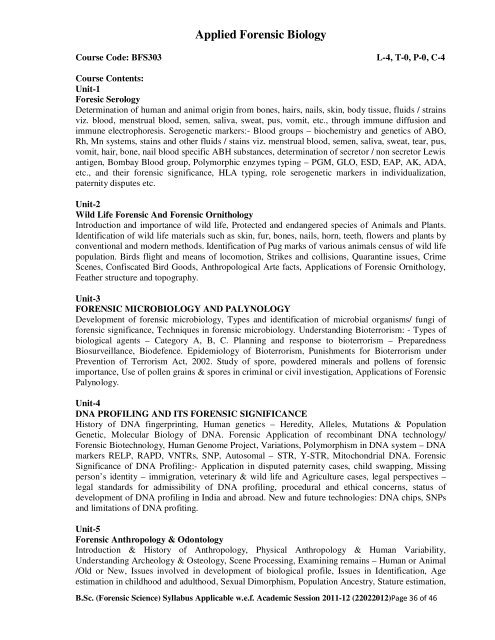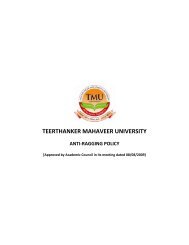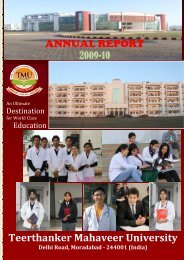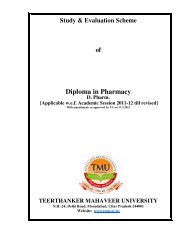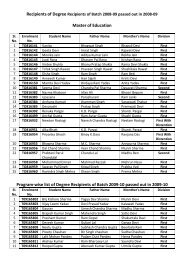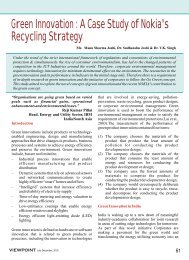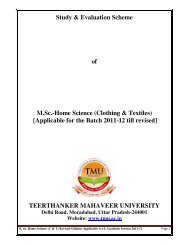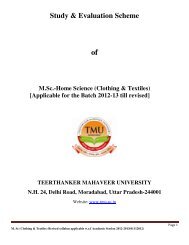Study & Evaluation Scheme of Bachelor of Science in Forensic ...
Study & Evaluation Scheme of Bachelor of Science in Forensic ...
Study & Evaluation Scheme of Bachelor of Science in Forensic ...
You also want an ePaper? Increase the reach of your titles
YUMPU automatically turns print PDFs into web optimized ePapers that Google loves.
Applied <strong>Forensic</strong> Biology<br />
Course Code: BFS303 L-4, T-0, P-0, C-4<br />
Course Contents:<br />
Unit-1<br />
Foresic Serology<br />
Determ<strong>in</strong>ation <strong>of</strong> human and animal orig<strong>in</strong> from bones, hairs, nails, sk<strong>in</strong>, body tissue, fluids / stra<strong>in</strong>s<br />
viz. blood, menstrual blood, semen, saliva, sweat, pus, vomit, etc., through immune diffusion and<br />
immune electrophoresis. Serogenetic markers:- Blood groups – biochemistry and genetics <strong>of</strong> ABO,<br />
Rh, Mn systems, sta<strong>in</strong>s and other fluids / sta<strong>in</strong>s viz. menstrual blood, semen, saliva, sweat, tear, pus,<br />
vomit, hair, bone, nail blood specific ABH substances, determ<strong>in</strong>ation <strong>of</strong> secretor / non secretor Lewis<br />
antigen, Bombay Blood group, Polymorphic enzymes typ<strong>in</strong>g – PGM, GLO, ESD, EAP, AK, ADA,<br />
etc., and their forensic significance, HLA typ<strong>in</strong>g, role serogenetic markers <strong>in</strong> <strong>in</strong>dividualization,<br />
paternity disputes etc.<br />
Unit-2<br />
Wild Life <strong>Forensic</strong> And <strong>Forensic</strong> Ornithology<br />
Introduction and importance <strong>of</strong> wild life, Protected and endangered species <strong>of</strong> Animals and Plants.<br />
Identification <strong>of</strong> wild life materials such as sk<strong>in</strong>, fur, bones, nails, horn, teeth, flowers and plants by<br />
conventional and modern methods. Identification <strong>of</strong> Pug marks <strong>of</strong> various animals census <strong>of</strong> wild life<br />
population. Birds flight and means <strong>of</strong> locomotion, Strikes and collisions, Quarant<strong>in</strong>e issues, Crime<br />
Scenes, Confiscated Bird Goods, Anthropological Arte facts, Applications <strong>of</strong> <strong>Forensic</strong> Ornithology,<br />
Feather structure and topography.<br />
Unit-3<br />
FORENSIC MICROBIOLOGY AND PALYNOLOGY<br />
Development <strong>of</strong> forensic microbiology, Types and identification <strong>of</strong> microbial organisms/ fungi <strong>of</strong><br />
forensic significance, Techniques <strong>in</strong> forensic microbiology. Understand<strong>in</strong>g Bioterrorism: - Types <strong>of</strong><br />
biological agents – Category A, B, C. Plann<strong>in</strong>g and response to bioterrorism – Preparedness<br />
Biosurveillance, Biodefence. Epidemiology <strong>of</strong> Bioterrorism, Punishments for Bioterrorism under<br />
Prevention <strong>of</strong> Terrorism Act, 2002. <strong>Study</strong> <strong>of</strong> spore, powdered m<strong>in</strong>erals and pollens <strong>of</strong> forensic<br />
importance, Use <strong>of</strong> pollen gra<strong>in</strong>s & spores <strong>in</strong> crim<strong>in</strong>al or civil <strong>in</strong>vestigation, Applications <strong>of</strong> <strong>Forensic</strong><br />
Palynology.<br />
Unit-4<br />
DNA PROFILING AND ITS FORENSIC SIGNIFICANCE<br />
History <strong>of</strong> DNA f<strong>in</strong>gerpr<strong>in</strong>t<strong>in</strong>g, Human genetics – Heredity, Alleles, Mutations & Population<br />
Genetic, Molecular Biology <strong>of</strong> DNA. <strong>Forensic</strong> Application <strong>of</strong> recomb<strong>in</strong>ant DNA technology/<br />
<strong>Forensic</strong> Biotechnology, Human Genome Project, Variations, Polymorphism <strong>in</strong> DNA system – DNA<br />
markers RELP, RAPD, VNTRs, SNP, Autosomal – STR, Y-STR, Mitochondrial DNA. <strong>Forensic</strong><br />
Significance <strong>of</strong> DNA Pr<strong>of</strong>il<strong>in</strong>g:- Application <strong>in</strong> disputed paternity cases, child swapp<strong>in</strong>g, Miss<strong>in</strong>g<br />
person’s identity – immigration, veter<strong>in</strong>ary & wild life and Agriculture cases, legal perspectives –<br />
legal standards for admissibility <strong>of</strong> DNA pr<strong>of</strong>il<strong>in</strong>g, procedural and ethical concerns, status <strong>of</strong><br />
development <strong>of</strong> DNA pr<strong>of</strong>il<strong>in</strong>g <strong>in</strong> India and abroad. New and future technologies: DNA chips, SNPs<br />
and limitations <strong>of</strong> DNA pr<strong>of</strong>it<strong>in</strong>g.<br />
Unit-5<br />
<strong>Forensic</strong> Anthropology & Odontology<br />
Introduction & History <strong>of</strong> Anthropology, Physical Anthropology & Human Variability,<br />
Understand<strong>in</strong>g Archeology & Osteology, Scene Process<strong>in</strong>g, Exam<strong>in</strong><strong>in</strong>g rema<strong>in</strong>s – Human or Animal<br />
/Old or New, Issues <strong>in</strong>volved <strong>in</strong> development <strong>of</strong> biological pr<strong>of</strong>ile, Issues <strong>in</strong> Identification, Age<br />
estimation <strong>in</strong> childhood and adulthood, Sexual Dimorphism, Population Ancestry, Stature estimation,<br />
B.Sc. (<strong>Forensic</strong> <strong>Science</strong>) Syllabus Applicable w.e.f. Academic Session 2011-12 (22022012)Page 36 <strong>of</strong> 46


